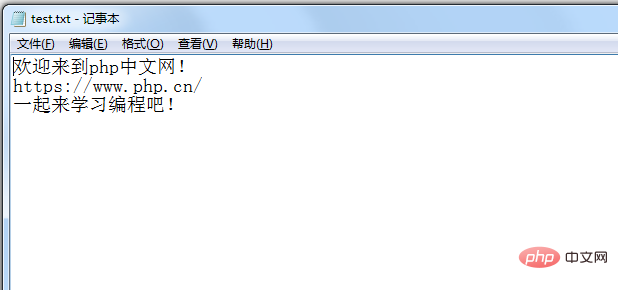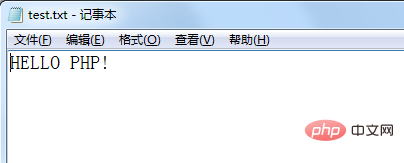PHP file operation: how to clear the file and re-add data
In the previous article, we introduced the method of reading all the data of the file at one time. If you are interested, you can click on the link to read "php file operation: How to obtain all the data of the file at one time". We have learned a lot about file reading operations. Let’s take a look at file writing operations.
As the title says, today’s topic is to introduce overwriting (clearing the original content of the file and then re-adding the data). Below we will give you a detailed introduction through code examples.
Still with the previous example, there is a text file named "test.txt", the content of which is:

I want to change "test. txt" file content is changed to:
HELLO PHP!
Let’s take a look at the implementation code:
<?php
header("Content-Type: text/html;charset=utf-8"); //设置字符编码
$file = "test.txt";
$handle = fopen($file, 'w'); //打开文件
fwrite($handle, 'HELLO PHP!'); //写入内容
fclose($handle);//关闭文件
?>After writing the content, we read the file and see if it is overwritten.
readfile($file); //读取并输出文件全部内容
Look at the output result:

Re-open the "test.txt" file and look at the content:

Write successfully! Let’s take a look at the key statements:
fopen($file, 'w') Statement: The fopen() function can open a file according to the specified file mode $mode ;When $mode is w or w , the contents of the file will be cleared while opening the file.
fwrite($handle, 'HELLO PHP!')Statement: Write the string "HELLO PHP!" to the open file.
In addition to using the fopen and fwrite() functions to overwrite and write, we can also directly use the file_put_contents() function to clear the original content of the file and re-add data.
Look at the following example:
<?php
header("Content-Type: text/html;charset=utf-8"); //设置字符编码
$file = "test.txt";
file_put_contents($file, '欢迎来到PHP中文网!'); //写入内容
readfile($file); //读取并输出文件全部内容
?>The output result is:

Reopen the "test.txt" file and look at the content :

Let’s take a look at the file_put_contents() function:
file_put_contents($filename,$data,$mode,$context)The function can write a string into a file and accepts two required parameters $filename (the file to be opened) and $data (the content to be inserted, which can be a string , one-dimensional array or resource type), two omitted parameters $mode and $context (the environment of the file handle).
Among them, the $mode parameter is used for how to open/write files (i.e. file mode), and has three values:
FILE_USE_INCLUDE_PATH: Default value, used to overwrite the original data.FILE_APPEND: If file $filename already exists, append data instead of overwriting.LOCK_EX: Obtain an exclusive lock while writing.
<?php
header("Content-Type: text/html;charset=utf-8"); //设置字符编码
$file = "test.txt";
file_put_contents($file, '欢迎来到PHP中文网!33',FILE_APPEND|LOCK_EX); //写入内容
readfile($file); //读取并输出文件全部内容
?>Reopen the "test.txt" file and take a look at the content:

As you can see, we are at the end of the file A new piece of data has been added! Therefore, the file_put_contents() function can not only be used to overwrite and write , but also append to write .
Okay, that’s all. If you want to know anything else, you can click this. → →Basic operation of PHP files
## Recommended: 《PHP interview questions summary (collection)》《php video tutorial》
The above is the detailed content of PHP file operation: how to clear the file and re-add data. For more information, please follow other related articles on the PHP Chinese website!

Hot AI Tools

Undresser.AI Undress
AI-powered app for creating realistic nude photos

AI Clothes Remover
Online AI tool for removing clothes from photos.

Undress AI Tool
Undress images for free

Clothoff.io
AI clothes remover

AI Hentai Generator
Generate AI Hentai for free.

Hot Article

Hot Tools

Notepad++7.3.1
Easy-to-use and free code editor

SublimeText3 Chinese version
Chinese version, very easy to use

Zend Studio 13.0.1
Powerful PHP integrated development environment

Dreamweaver CS6
Visual web development tools

SublimeText3 Mac version
God-level code editing software (SublimeText3)

Hot Topics
 1376
1376
 52
52
 PHP 8.4 Installation and Upgrade guide for Ubuntu and Debian
Dec 24, 2024 pm 04:42 PM
PHP 8.4 Installation and Upgrade guide for Ubuntu and Debian
Dec 24, 2024 pm 04:42 PM
PHP 8.4 brings several new features, security improvements, and performance improvements with healthy amounts of feature deprecations and removals. This guide explains how to install PHP 8.4 or upgrade to PHP 8.4 on Ubuntu, Debian, or their derivati
 CakePHP Date and Time
Sep 10, 2024 pm 05:27 PM
CakePHP Date and Time
Sep 10, 2024 pm 05:27 PM
To work with date and time in cakephp4, we are going to make use of the available FrozenTime class.
 CakePHP File upload
Sep 10, 2024 pm 05:27 PM
CakePHP File upload
Sep 10, 2024 pm 05:27 PM
To work on file upload we are going to use the form helper. Here, is an example for file upload.
 Discuss CakePHP
Sep 10, 2024 pm 05:28 PM
Discuss CakePHP
Sep 10, 2024 pm 05:28 PM
CakePHP is an open-source framework for PHP. It is intended to make developing, deploying and maintaining applications much easier. CakePHP is based on a MVC-like architecture that is both powerful and easy to grasp. Models, Views, and Controllers gu
 CakePHP Creating Validators
Sep 10, 2024 pm 05:26 PM
CakePHP Creating Validators
Sep 10, 2024 pm 05:26 PM
Validator can be created by adding the following two lines in the controller.
 CakePHP Logging
Sep 10, 2024 pm 05:26 PM
CakePHP Logging
Sep 10, 2024 pm 05:26 PM
Logging in CakePHP is a very easy task. You just have to use one function. You can log errors, exceptions, user activities, action taken by users, for any background process like cronjob. Logging data in CakePHP is easy. The log() function is provide
 How To Set Up Visual Studio Code (VS Code) for PHP Development
Dec 20, 2024 am 11:31 AM
How To Set Up Visual Studio Code (VS Code) for PHP Development
Dec 20, 2024 am 11:31 AM
Visual Studio Code, also known as VS Code, is a free source code editor — or integrated development environment (IDE) — available for all major operating systems. With a large collection of extensions for many programming languages, VS Code can be c
 CakePHP Quick Guide
Sep 10, 2024 pm 05:27 PM
CakePHP Quick Guide
Sep 10, 2024 pm 05:27 PM
CakePHP is an open source MVC framework. It makes developing, deploying and maintaining applications much easier. CakePHP has a number of libraries to reduce the overload of most common tasks.




